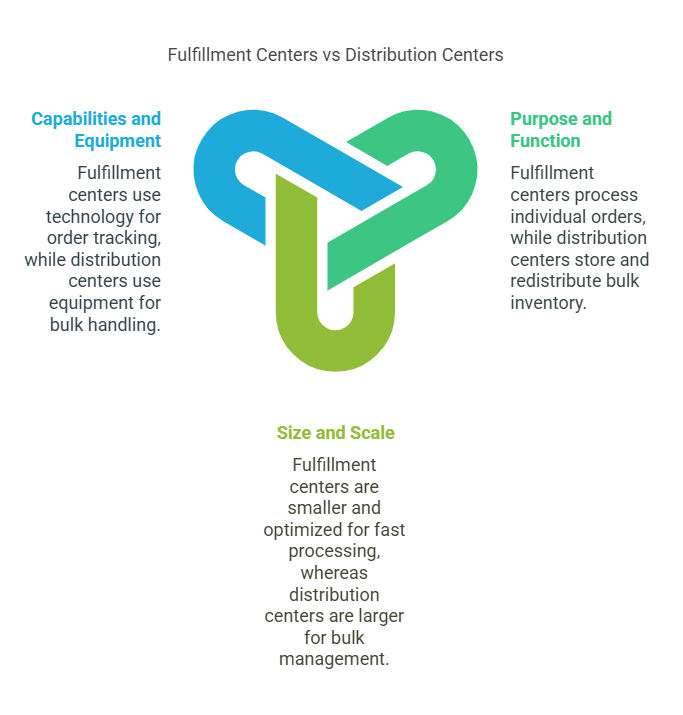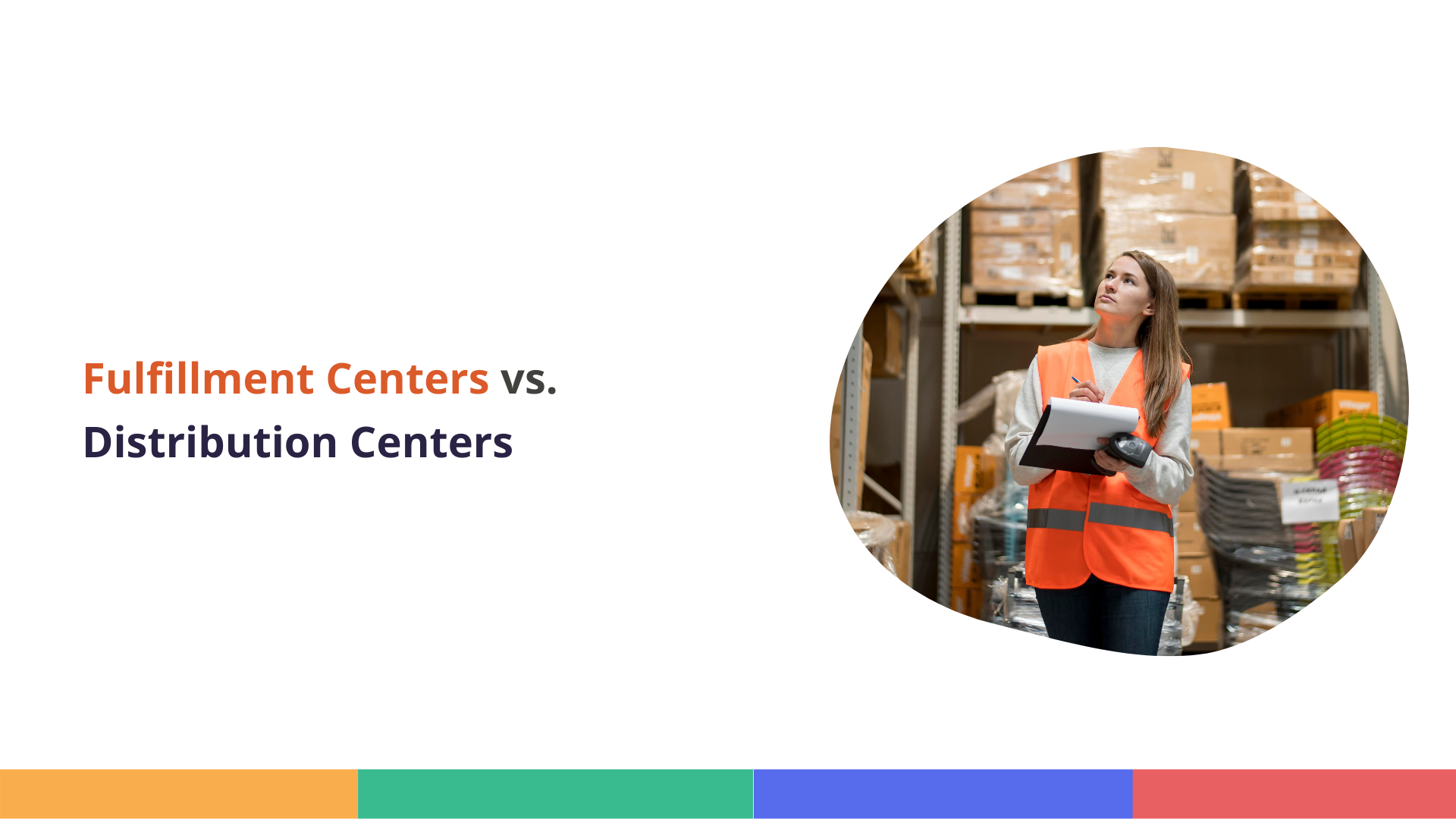Here are some key differences between Fulfillment Centers vs Distribution Centers:
When you run an online retail business, every step in your supply chain counts. From sourcing products to getting them into your customers’ hands, logistics is a critical component that can make or break your success. Two key facilities in this journey are fulfillment centers and distribution centers. Although these terms are often used interchangeably, they play very different roles. In this guide, we’ll break down what each one does, why it matters, and how you can choose the right solution for your business—all in plain, human language.
What Is a Fulfillment Center?
A fulfillment center is essentially a specialized warehouse designed to handle all aspects of order processing for your online store. When a customer places an order, fulfillment centers take over: they store your inventory, pick the right items from the shelves, pack them securely, and ship them out using a third-party carrier. The goal here is to complete the order accurately and quickly so that your customers receive their purchases on time and in perfect condition.
For small businesses, partnering with a fulfillment center can be a great way to outsource the logistical heavy lifting. Instead of managing an in-house warehouse, you can focus on growing your brand while experts handle inventory management and shipping. These centers often use advanced warehouse management systems to keep track of stock levels, ensuring that products don’t run out or sit idle for too long. The result is a smoother operation and happier customers.
What Is a Distribution Center?
On the other hand, a distribution center is more about moving large quantities of products in bulk. Distribution centers serve as hubs that store products for resale or for further distribution to retailers, wholesalers, or even other warehouses. They are critical in the supply chain, especially for manufacturers who need to move large volumes of products from the production facility to various sales points.
In a distribution center, the focus is on handling bulk shipments rather than individual customer orders. Products are typically stored on pallets and managed with equipment like forklifts and pallet jacks. These centers ensure that large quantities of goods are efficiently processed, which is key for businesses that supply multiple retail outlets or operate in B2B environments.
For example, a manufacturer of electronics might use a distribution center to store and then redistribute its products to various retail stores across the country. In contrast, a small online boutique would use a fulfillment center to process and ship orders directly to customers.
Fulfillment Centers vs Distribution Centers: 3 Key Differences
While both types of centers are essential to the supply chain, here are the three major differences that set them apart:

1. Purpose and Function
- Fulfillment Centers:
These facilities are geared toward individual order processing. They pick, pack, and ship products directly to customers. If you run an online store where customers place orders one at a time, a fulfillment center is designed to handle that type of volume and detail. - Distribution Centers:
Distribution centers are built to handle bulk inventory. They store large quantities of products and then redistribute them to retailers or other warehouses. Think of them as a strategic hub in the supply chain that helps balance supply and demand over a wide area.
2. Size and Scale
- Fulfillment Centers:
Fulfillment centers can vary in size depending on the business needs. They’re often designed to be agile and efficient, handling a high volume of individual orders. The space is optimized with storage bins, labeling machines, and packing stations. - Distribution Centers:
Typically much larger, distribution centers use pallet storage and heavy-duty equipment to manage bulk inventory. They are designed for high-volume operations and usually require more space, as they handle shipments for multiple retailers or regions.
3. Capabilities and Equipment
- Fulfillment Centers:
Equipped with tools to handle detailed order processing, these centers have systems for tracking individual orders, managing returns, and ensuring accurate packaging. Technologies like barcode scanners, RFID, and order management software are common. - Distribution Centers:
These centers focus on efficiency in handling large shipments. They use equipment like forklifts, pallet jacks, and automated sorting systems. The technology is geared more toward bulk handling, ensuring that large volumes of products are moved quickly and safely.
Why Does This Matter for Your Online Business?
Understanding the difference between fulfillment centers and distribution centers is key to optimizing your supply chain. Here’s why:
- Customer Experience:
A fulfillment center directly impacts the customer’s experience by ensuring that individual orders are processed quickly and accurately. When your customers receive their orders on time and in good condition, it builds trust and encourages repeat business. - Cost Efficiency:
Choosing the right type of center for your needs can save you money. For instance, if you need to process many small orders, a fulfillment center offers the specialized services required. Conversely, if you handle large bulk orders, a distribution center may offer better rates and efficiency. - Operational Focus:
Outsourcing order processing to a fulfillment center allows you to focus on core business activities like marketing, product development, and customer service. Similarly, using a distribution center for bulk inventory management can free up resources and reduce operational headaches. - Scalability:
As your business grows, your logistics needs will evolve. Understanding these two types of centers helps you plan for expansion. You might start with a fulfillment center and eventually incorporate a distribution center as you scale up your operations and diversify your sales channels.
FAQs About Fulfillment and Distribution Centers
Q: What exactly is a fulfillment center?
A: A fulfillment center is a specialized warehouse that processes individual customer orders. It handles inventory storage, order picking, packing, and shipping directly to customers.
Q: How is a distribution center different from a fulfillment center?
A: A distribution center deals with bulk inventory management and redistributes products to retailers or other warehouses. It’s focused on moving large quantities of goods rather than processing individual orders.
Q: Which one should I choose for my online business?
A: It depends on your needs. If you’re processing many individual orders, a fulfillment center is ideal. If your business involves large-volume shipments to multiple retailers, a distribution center might be more suitable.
Q: Can I use both in my supply chain?
A: Absolutely! Many businesses use fulfillment centers for direct-to-consumer orders and distribution centers for handling bulk inventory. This hybrid approach can optimize your entire supply chain.
Q: How do technology and tracking differ between the two?
A: Fulfillment centers usually employ detailed tracking systems for individual orders, using tools like barcode scanners and RFID. Distribution centers focus on bulk processing and may use large-scale sorting and pallet management systems.
Final Thoughts
Choosing the right logistics setup is crucial for your online retail business. Whether you need the precision of a fulfillment center or the capacity of a distribution center, understanding their unique roles will help you build a more efficient, scalable, and customer-friendly supply chain.
By carefully evaluating your needs, leveraging the right technology, and asking the right questions, you can create a logistics strategy that supports your business growth and delights your customers. Remember, the goal is to deliver a seamless experience that reflects your brand’s commitment to quality and reliability.
Take the time to explore your options, run pilot tests, and gather feedback. Your logistics partner should be more than just a vendor—they should be a true extension of your brand. With the right approach, you can overcome logistical challenges and set your business up for long-term success.


